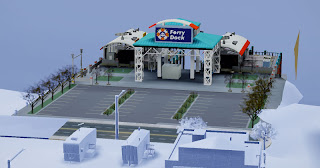If this game were solely about zoning RCI (residential, commercial, industrial zones), then you would be bored with it within five to thirty-seven minutes. The key to what makes SimCity fun is the ploppable buildings and how they help, hinder, or satisfy the Sims and their needs.
But what are these needs? What is it that the citizens of your great city want?
If you focus on any one individual person, their needs change wildly. But as a group, their needs are all the same and simply providing umbrella services that address all the needs as they come up is the key to maintaining your sanity and making sure your plebs are provided for. Here's what we know about our loyal flock:
They Populate
Your citizens comes from some mysterious place out in the world -- having heard about your fledgling community via Twitter. When they arrive, they claim land and embark on their new lives completely unsupervised.
They Plop

Your citizens take care of their own houses. After determining which zone an area must be, the Sims will take it from there. If the land value or density goes up or down, the people who live in the neighborhood will build or tear down as necessary. This is a good thing, as seeing to the day-to-day whims of architecture and construction would be monotonous.
They Party
Your citizens are always in the market for a good time. When they get it, they become happy and your city thrives. However, when they party, your Sims also generate a lot of garbage.
They Play
Your citizens and those from surrounding cities are always looking to go on vacation. The number one thing they want to see when they come to your city from afar: parks. Then casinos. Then ferry rides to nowhere. But mostly parks.
They Peruse
Your citizens want to be more than they are. They are willing to learn if you supply them with schools, colleges, and universities. Then, they will apply that knowledge to their lives, using less resources in their day-to-day lives and upgrading their factories to produce cleaner, more expensive products.
They Pontificate
Your citizens are always willing to give you their opinion. While looking across the vast layout of your city, you will be bombarded with feedback -- both good and bad.

Your citizens will also ask for things. They will challenge you, dare you, and otherwise occupy you so that you can delve into the bowls of your city on a micro- level as deep as you see fit. You can tell what your citizens want by the color of their speak bubble:
- white bubbles: challenge -- they want to help or test you with a challenge that you can then pass or fail. These are mostly requests or dares.
- green bubbles: satisfaction -- they like what you're doing
- orange bubbles: general opinion about the city
- red bubbles: dissatisfaction -- they hate something about your city
They Pile-Up
Your citizens tell their friends about their lives. When you're doing well as a mayor, more and more people will want to be apart of something special. They will pack it in and build apartments, skyscrapers, and shopping malls to fit the maximum number of people onto each square foot of land.
They Produce
Your citizens want money and they're willing to work quite hard to get it. Once they've become highly-educated, they'll make lots of money and share some of it with you. Think of your people as thousands of money to happiness converters.
They Faux Pas
Your citizens will sometimes make mistakes. They set their houses on fire and let themselves go until they have to go to the hospital. Anticipate that sliver of your population that doesn't have a clue and set up services to keep them from harming themselves and others.
They Poop
Your citizens are members of a first world country. As a result, they make waste. Lots and lots of waste. They make bathroom waste after they eat. They make garbage waste after they buy stuff. They make smoke waste whenever they drive their cars: usually to eat and buy stuff.

The problem with living on a road by yourself is that anyone can identify your personal poop.
They Pilfer
Your citizens are mostly good, decent people who would never think of crime. But there are some bad seeds that will steal from others simply because it's easier than doing it the honest way. Set up a police force to maintain law and order.
At the end of the day, the best way to make it to the top of the leaderboard is by understanding what your people want and don't want by putting yourself in their shoes and then building a town to suit. Either you build a town that handles everything Sims don't want (pollution, sewage) and then charge others to take care of their problems or you build a perfect town full of happiness and shops and then ship your crap to your neighbors.
In short: always keep your people in mind.












































